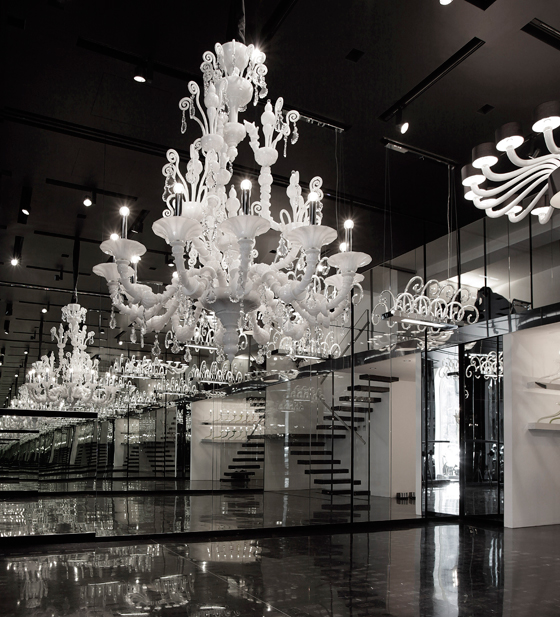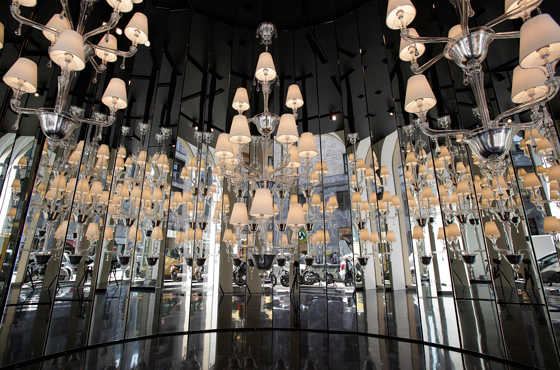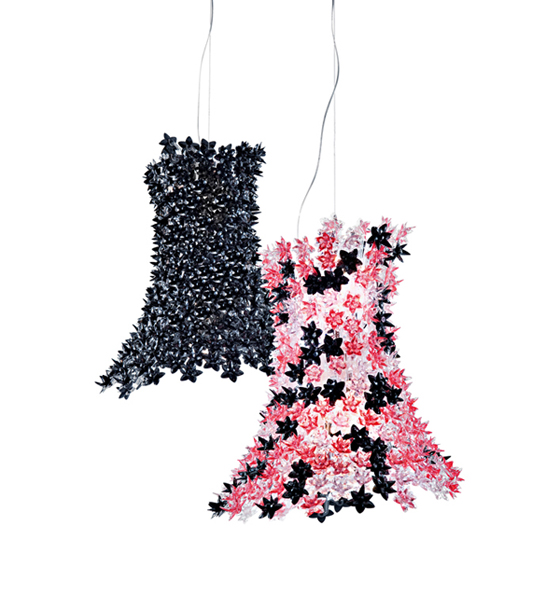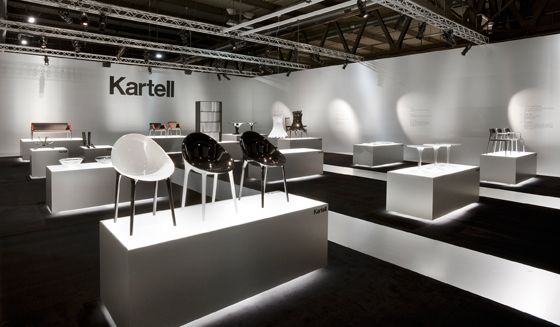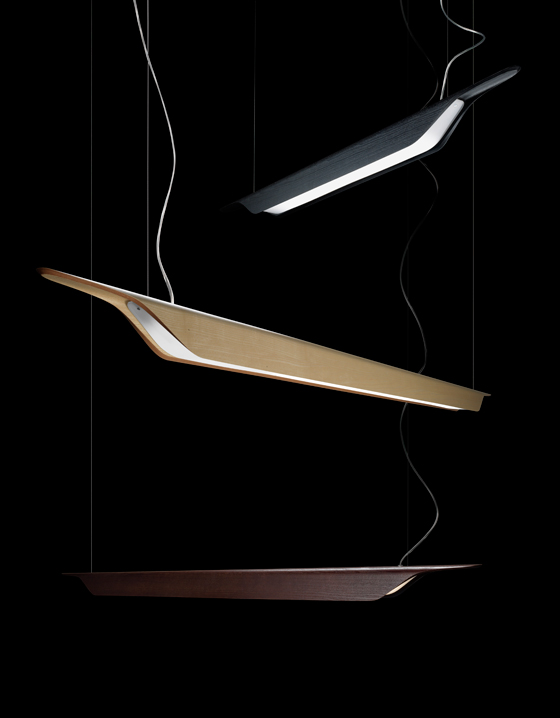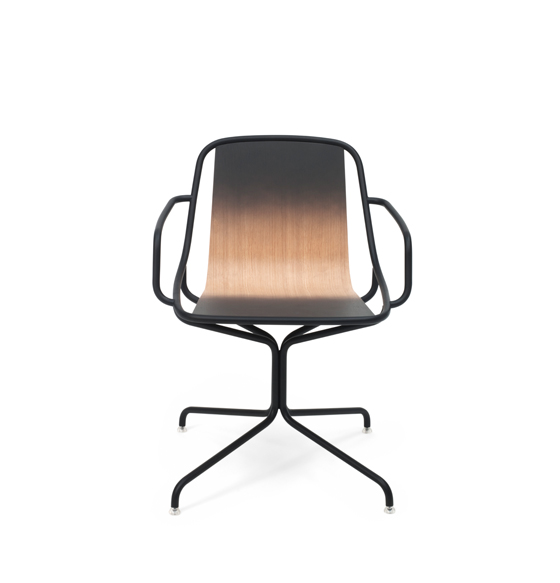The Milan Conversations: Part IV – Ferruccio Laviani and Luca Nichetto
Texte par Simon Keane-Cowell
Zürich, Suisse
20.05.10
In this final installment of the Milan Conversations we catch up with renowned product designer, architect and artistic director of Italian manufacturer Kartell Ferruccio Laviani at the Barovier&Toso showroom in Milan and talk to him about lamps, light bulbs, and the significance of going back to basics. We also meet young(ish) Venetian designer Luca Nichetto (whose client list already reads like a 'who's who' of high-end design manufacturing) and find out his take on this year's Salone.
Kartell's monochromatic stand at this year's Milan Salone del Mobile, designed by Ferruccio Laviani; Laviani's 'Bloom' lights in foreground
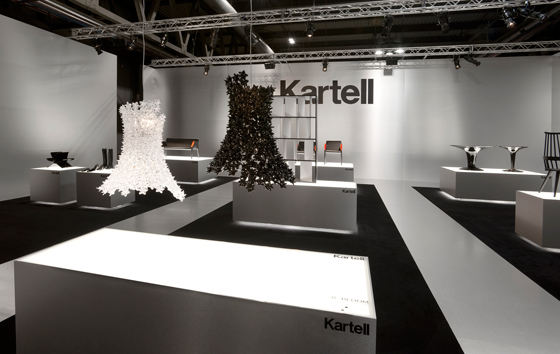
Kartell's monochromatic stand at this year's Milan Salone del Mobile, designed by Ferruccio Laviani; Laviani's 'Bloom' lights in foreground
×.....
FERRUCCIO LAVIANI – 'If you create a bad lamp design, it's the fault of the designer, not the bulb'
I've been the owner of a black Kartell 'Bourgie' lamp for some years now, which, for a number of reasons, resides in my old bedroom at my parents' house. Each time I go home, I'm reminded just how much of an affective effect the piece has on me. It makes me happy. I love that emotional connection with design. Your work here at the Barovier&Toso showroom is also very evocative. Is that a very conscious part of the way that you work?
It makes me laugh that you have this lamp at your parents' home because the piece is a reference to a present my parents gave me – an old 17th-century candlestick. This is where the form of the 'Bourgie' lamp comes from. The brief from Kartell had been to create a new light with a big investment in moulding. So it makes me smile that you have the 'new' lamp at your parents' house because the old, original present from my parents reminds me very much of home. And for you, your 'Bourgie' lamp is a connection with home. And it's this feeling of home that I wanted to create with the object.
Ferruccio Laviani: 'The world needs some kindness at the moment. We really don't live in a kind world'; photo Francesca Rivetti
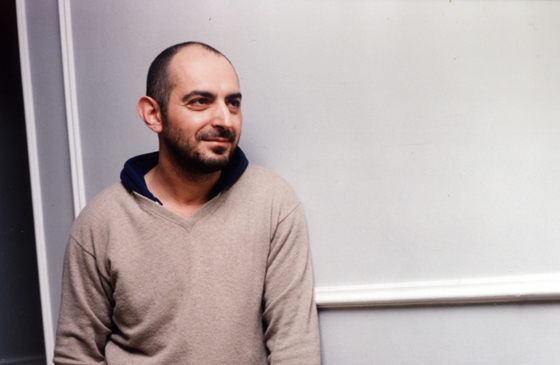
Ferruccio Laviani: 'The world needs some kindness at the moment. We really don't live in a kind world'; photo Francesca Rivetti
×The installation here at the Barovier&Toso showroom is as much an architectural project as a product-design one. You've given so much consideration to designing lighting. Is there a connection, do you think, between being an architect and defining and shaping space through light?
Yes, this was an architectural project. I cleaned out the old showroom, to amplify the space in order to really display the lamps. The result is a space that reflects the things in it. But I'm not so technically skilled to say I can define space through light. I'm much more able to define the shape of a light itself, as an object, which then gives a space a certain feeling. When I'm working on a shop or something like that, I prefer to work with a lighting consultant.
Barovier&Toso's new showroom in Milan, designed by Ferruccio Laviani
Does the issue of energy consumption influence your thinking when you take on a lighting project like this at Barovier&Toso or, indeed, in terms of your work in general?
Yes. All the time. I think we are all more conscious of this. Things have changed. There's a chain of decisions that takes you through a project, which can help you save energy. But it's not just about energy. It's also about the materials that you use. It's a lot of things. This kind of approach requires a kind of interaction between you and all the other professionals that you are involved with. Naturally, we have started using more LED lights. But I try not to make too many sacrifices on any project and instead try to use existing energy-saving technology. But new environmentally positive things are being developed all the time, for sure.
Barovier&Toso's new showroom in Milan, designed by Ferruccio Laviani
I bought a new Anglepoise lamp recently – the classic 1930s George Carwardine design – and it came with an energy-saving bulb, one of those spiral ones...
And you said 'Oh, God.'
(Laughs.) And I thought 'Oh, no. I'll have to change that.' There was a visual dissonance there between the bulb and this beautiful piece. I guess the challenge is not to lose that sense of visual pleasure when coming up with new technologies that are obviously needed to help the environment. That's if you believe that design has as much of an aesthetic function as it does a practical one.
This is a problem we were already thinking about when I was artistic director for Flos. If you take Achille Castiglioni's huge 'Taraxacum' lamp, for example, it's made up of bulbs. Obviously, this piece was born in a different time. This problem of energy-saving bulbs or elements is one that affects older projects in particular. Now, of course, things are changing. Before, lamps had a large head because they had to hide a big bulb. If you think of Michele de Lucchi's 'Tolomeo' lamp, its shape, its dimensions, are informed by the bulb inside. Now when you start to think about an object or a lamp, you think LED. Table lamps are now so completely different than before. Technology is influencing form. But really I think that if you create a bad lamp design, it's the fault of the designer, not the bulb.
What was the motivation behind your new 'Bloom' light for Kartell?
Three years we did a big presentation of my lamp projects for Kartell in a Dolce & Gabbana space. We displayed all the projects that I'd done – those that had gone into production and those that hadn't. 'Bloom' was one of the ideas that had been created as part of 60 proposals for new lights. When we went to develop it, we realised it was more complicated than we had imagined. Firstly, it requires a lot of moulding, which means a lot of money has to be invested. Another problem was that Claudio Luti (CEO of Kartell) didn't want to sell the lamp as a self-assembly piece. He wanted it finished. Of course, applying all the flowers requires labour, which costs money.
How did you resolve the various issues?
By fighting for the project. And I fought for it because I really wanted this to be a Kartell object and a popular design. In the end I convinced Mr Luti to agree to produce the piece without the flowers, with the owner adding them to the lamp once they've taken the piece home. This halves the cost of the piece.
I made this lamp, because they wanted something very strong, very iconographic, very recognisable as a Kartell object. With its flowers, its strongly poetic, and I like that. It's a romantic object. The world needs some kindness at the moment. We really don't live in a kind world.
Ferruccio Laviani's black-and-white stand design for Kartell at the 2010 Milan Salone del Mobile
What was the rationale for this year's monochromatic presentation of Kartell's novelties at the Salone? For me, given the fact that there's a consistent use of a particular material across all of Kartell's products – polycarbonate – it makes everything much more graphic and strong.
Yes, absolutely. I used black and white this year, as opposed to last year's colourful presentation, because I wanted to move away from the 'fun' aspect of Kartell and present the company as what it really is – a 60-year-old company that makes serious projects. This year, there were 13 very important projects, so it was vital for me to respect the company's huge investment. It was a way of resetting the image of Kartell, to take it back to basics. Mr Luti found this a risk at first. But I said 'We have to make people understand what the real heart of Kartell is.' It's about the design. The shape of the objects in black without any other interferences.
The products in silhouette, essentially.
People might think it's a bit arrogant. But for me it's about showing the objects for what they are. And the effort that the company is making to produce in a period of crisis that we find ourselves in.
It's an impressive collection. And, as you say, it makes a clear statement about the company's investment in good design. So what happens next year?
Well, I hope to be able to do something interesting again. Next year is Euroluce, too, so I hope to show a whole new collection of lamps. I have a big meeting about strategy after the Salone del Mobile, so we will see.
That sounds serious.
Well, yes. (Laughs.)
Thanks very much, Ferruccio. It's been great talking to you.
.....
LUCA NICHETTO – 'Working with a company is a bit like a ping-pong game'
Everywhere I've been this week there seemed to be one of your products on show. That must have been an intense but interesting process, working for so many different manufacturers.
Well, this has been a super year for me. What I learned from it all is that to do a really good job, you have to invest in the people you're working with. I've had the opportunity in the past to work for Moroso, which was a dream come true. But it wasn't easy. Working with a company is a bit like a ping-pong game. If you hit the ball and it's not returned, that's difficult. Of course, it's great to be associated with a good company, but it doesn't always help you learn. So this year has been the best for me so far – to produce 11 new products with fantastic people. My dream for the future is to be able to continue to have these kinds of relationships.
Luca Nichetto: 'I hope the crisis has created the possibility to create good-quality products that are really needed, instead of exhibition pieces'; photo Markus Moström
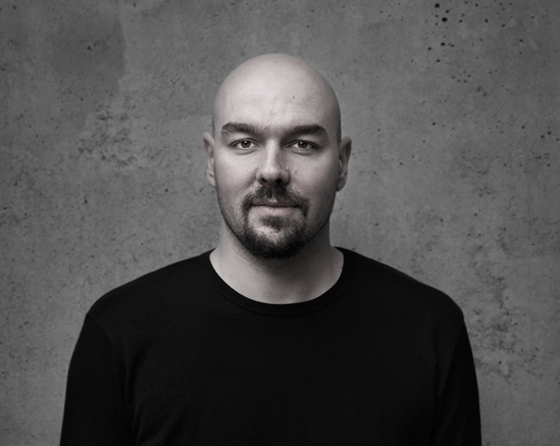
Luca Nichetto: 'I hope the crisis has created the possibility to create good-quality products that are really needed, instead of exhibition pieces'; photo Markus Moström
×I guess we like to think that good design, in terms of the finished product, should speak to us, should encourage the user to form a long-lasting relationship with it. Why not the production side of design, too? Maybe projects that are borne out of very good relationships between designers and manufacturers make for better products.
I agree. I think there are too many new products every year. Good products are ones that come out a good understanding. Many of my friends have said to me that I've produced too much this year. Maybe that's true. But I think every product I've designed has taught me to be better in some way. Maybe next year you'll just see two or three products of mine in Milan. It's not important for me to continue at this pace. It's about having a good connection with the manufacturer. It you don't have one, it can't work.
'Troag' lamp by Luca Nichetto for Foscarini; photo Massimo Gardone
What's your general impression of Milan this year?
I really hope that level of the fair has changed this year. I hope the crisis has created the possibility to create good-quality products that are really needed, instead of exhibition pieces. I think it's important that objects have a strong emotional value, that they're not just fashion items. For example, Fabio Novembre's face-chair ('Nemo') for Driade is sculpture. For me, it's not design. Industrial design in the past was about a good object that was also commercially successful. In the last 15 years, the idea of design as a fantastical object has come about, an object that you buy, keep for a couple of years and then don't want to have in your home anymore. This is fashion.
And from an environmental point of view...
It's a disaster.
Absolutely.
It's so important now to design cleverly, to understand not only how to create a new object but to think about what's going to happen to that object once it's bought. What is going to happen to it once it's no longer wanted by the owner. Or why the owner might no longer want it.
As in what happens to a product when we fall out of love with it, when we want to get out of our relationship with it.
Well, thinking about this changes the concept of any project completely. I think this is the future. Or should be the future for all designers.
Thanks very much, Luca.
.....


